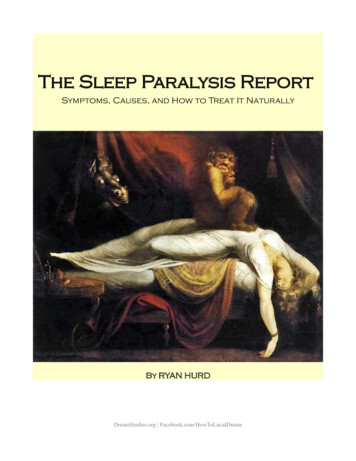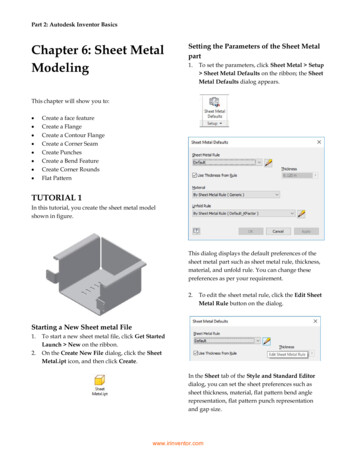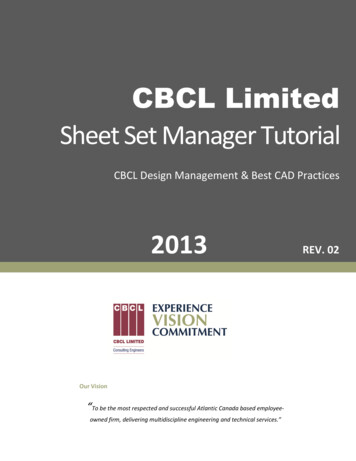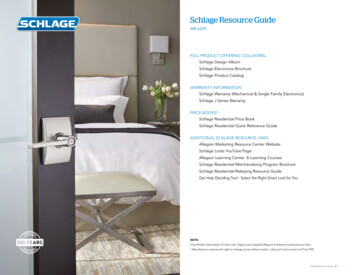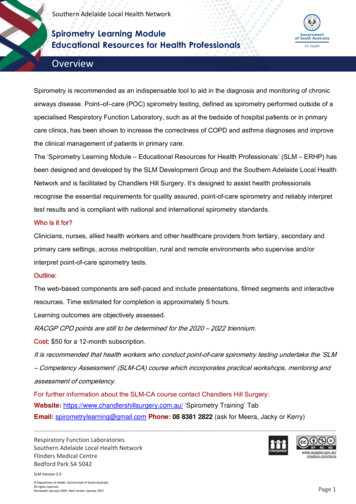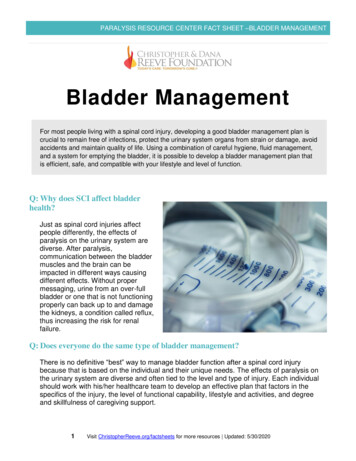
Transcription
PARALYSIS RESOURCE CENTER FACT SHEET –BLADDER MANAGEMENTBladder ManagementFor most people living with a spinal cord injury, developing a good bladder management plan iscrucial to remain free of infections, protect the urinary system organs from strain or damage, avoidaccidents and maintain quality of life. Using a combination of careful hygiene, fluid management,and a system for emptying the bladder, it is possible to develop a bladder management plan thatis efficient, safe, and compatible with your lifestyle and level of function.Q: Why does SCI affect bladderhealth?Just as spinal cord injuries affectpeople differently, the effects ofparalysis on the urinary system arediverse. After paralysis,communication between the bladdermuscles and the brain can beimpacted in different ways causingdifferent effects. Without propermessaging, urine from an over-fullbladder or one that is not functioningproperly can back up to and damagethe kidneys, a condition called reflux,thus increasing the risk for renalfailure.Q: Does everyone do the same type of bladder management?There is no definitive “best” way to manage bladder function after a spinal cord injurybecause that is based on the individual and their unique needs. The effects of paralysis onthe urinary system are diverse and often tied to the level and type of injury. Each individualshould work with his/her healthcare team to develop an effective plan that factors in thespecifics of the injury, the level of functional capability, lifestyle and activities, and degreeand skillfulness of caregiving support.1Visit ChristopherReeve.org/factsheets for more resources Updated: 5/30/2020
PARALYSIS RESOURCE CENTER FACT SHEET –BLADDER MANAGEMENTQ: What is a neurogenic bladder, spastic and flaccid bladder?The neurogenic bladder is a catch-all termused to describe the urinary complications ofparalysis. Two effects of spinal trauma onthe neurogenic bladder are spastic bladderand flaccid bladder. With a spastic bladder,the bladder empties without warning andoutside of conscious control. Also calledreflex bladder or hyperactive bladder,spastic bladder is most common in injuriesat T12 or above. In contrast, flaccid bladderoccurs when the reflexes of the bladdermuscles are sluggish or absent, so you donot feel when the bladder is full. Also callednon-reflex or floppy bladder, flaccid bladderincreases the risk of bladder distension andinfection and typically occurs in injurieslower than T12.Considerations for developing yourbladder management plan:· How can you simplify your bladdermanagement as much as possible?· How will you handle cathing when not athome?· What do you need to ensure as little riskof contamination as possible?· How can you adjust your schedule oractivities with the need to regularlyempty your bladder?· What type of catheterization should youconsider?Q: Are there different bladderconsiderations for men versus women?Urine passes from the bladder through the urethra out of your body. In women, the urethra isright above the vagina, and this location can make it difficult for women with limited mobilityto keep the area around a catheter clean. A surgical option called the Mitrofanoff procedurecan be beneficial to women as it constructs a new passageway for urine using the appendixor bowel to allow catheterization to be done through the abdomen. Since a man’s urethra isin the penis, a reflex voiding option can be used to squeeze a full bladder into an externalcondom catheter. These catheters fit like a condom around the penis and connect to a tubeand collection bag. There is no effective external collecting device for women. Indwellingcatheters (Foley and suprapubic catheters) can be used by men and women.Q: What are some of the types of catheters used in bladder management?There are a number of different types of catheters available including single-use cathetersand lubricated catheters (sometimes called hydrophilic catheters) to meet individual abilitiesand needs. The three most common methods of bladder emptying are with intermittentcatheterization (IC), an indwelling catheter (suprapubic or Foley) and an external condomcatheter for men. Most people with spinal cord injury start out using intermittentcatheterization which involves inserting a catheter into the urethra to drain the bladder on aregular schedule (typically every 4 to 6 hours or so) and then it is removed. An indwelling orFoley catheter remains in place in the urethra to continuously drain urine which is collectedin an external bag. For men, external Texas catheters or condom catheters are an option, inconjunction with an external collection method such as a leg bag.2Visit ChristopherReeve.org/factsheets for more resources Updated: 5/30/2020
PARALYSIS RESOURCE CENTER FACT SHEET –BLADDER MANAGEMENTQ: What are some options and how do you choose what works best for you?Most people need to try different approaches in order to find the method that worksdepending on their level of injury and a spastic or flaccid bladder. When considering youroptions, think about a plan that includes ease of use, convenience, discreetness, andpsychological well-being as well as a decreased risk of infections, complications and bladderaccidents. In addition to the catheterization methods mentioned above, there are severalsurgical alternatives including Mitrofanoff procedure (constructs a new passageway for urineusing the appendix or bowel), bladder augmentation (uses tissue from the intestines toenlarge the bladder capacity), urostomy (creates a surgical opening to drain urine into aplastic pouch), and sphincterotomy (weakens the bladder neck and sphincter muscle to allowurine to flow out more easily).Q: How do you determine if you have a urinary tract infection (UTI) and what is thebest protocol to follow for treatment?Even with a regular bladder management program and proper prevention methods, the riskremains for urinary tract infection (UTI). Some of the symptoms of UTI are cloudy, smellyurine, fever, chills, nausea, headache, increased spasms, burning while urinating andautonomic dysreflexia (AD). To diagnose a UTI, your healthcare provider will collect urine fora urinalysis and a culture. A culture should be done to identify the most responsive antibioticfor your case thus minimizing antibiotic resistance. Since it is common to have bacteriacolonized in your bladder when you use a catheter, antibiotics are not recommended unlessyou have a fever or symptoms are limiting normal activities. Ongoing medical care andregular check-ups with complete UT examination are essential for anyone with an SCI.Sources: Craig Hospital, Model Systems Knowledge Translation Center, Christopher & DanaReeve Foundation bladder management bookletNeed to talk to someone?Our Information Specialists are available to answer your questions.Call toll-free 1-800-539-7309 Mon-Fri, 9am-5pm ET.Or schedule a call or ask a question online.3Visit ChristopherReeve.org/factsheets for more resources Updated: 5/30/2020
PARALYSIS RESOURCE CENTER FACT SHEET –BLADDER MANAGEMENTResources for Bladder Management:Paralyzed Veterans of America: Bladder Management Following Spinal Cord Injury—What You Should Know (consumer version)Can be downloaded for free from the PVA websiteParalyzed Veterans of America: Bladder Management for Adults with Spinal Cord Injury—A Clinical Practice Guideline for Health Care ProfessionalsCan be downloaded for free from the PVA websiteChristopher & Dana Reeve Foundation: Bladder Management bookletAvailable for free download or call an Information Specialist for a printed copy at 800-539-7309.Craig Hospital: Bladder Care ResourcesCraig Hospital: Urinary Tract Infection Signs and SymptomsAmerican Urological Association Foundation1000 Corporate BoulevardLinthicum, MD 21090Phone: 410-689-3700, 1-800-828-7866E-mail: info@urologycarefoundation.orgThe AUA Foundation provides patient information and a resource center.Bladder and Bowel FoundationBladder and Bowel Community7 The CourtHolywell Business ParkNorthfield RoadSoutham, UKCV47 0FSEmail: help@bladderandbowelfoundation.orgOffers support and information to those living with bowel or bladder dysfunction.Government of Western Australia: Troubleshooting for Your CatheterTips on how to deal with problems you may encounter in using catheters.Medline Plus: Urinary CathetersInformation on various kinds of urinary catheters.Model Systems Knowledge Translation Center: Bladder Management Options After SCIMultiple Sclerosis Association of America: Bladder DysfunctionNational Kidney and Urologic Diseases Information Clearinghouse: Your Urinary System4Visit ChristopherReeve.org/factsheets for more resources Updated: 5/30/2020
PARALYSIS RESOURCE CENTER FACT SHEET –BLADDER MANAGEMENTand How it WorksThe National Kidney and Urologic Diseases Information Clearinghouse provides an overview ofthe urinary system (also available as a printable PDF) and links to other organizations that canprovide additional information.National Stroke Association: Bladder and Bowel FunctionNorthwest Regional Spinal Cord Injury System, University of Washington School ofMedicine, Rehabilitation MedicineThe University of Washington School of Medicine/Department of Rehabilitation Medicine offersdetails on bladder management, including downloadable pamphlets, reports, and videos.Bladder ManagementUrinary Tract Infections: Intermittent CatheterizationUrinary Tract Infections: Indwelling (Foley) CatheterManagement of Urinary Problems Caused by Spinal Cord Injury (report and streamingvideo, 65 minutes)Intrathecal Baclofen Therapy for Spasticity (report and streamingvideo, 85 minutes)Society of Urologic Nurses and Associates: Clinical Practice Guidelines—Adult CleanIntermittent CatheterizationSpinal Injury Information NetworkThe Spinal Cord Injury Information Network lists various resources related to bladder function,including fact sheets, articles, and forums.To find catheter and catheter supply companies and distributors, see:AbleData databaseListings related to catheters can be accessed by clicking on Products, then clicking on Aids forDaily Living, then scrolling down to the Toileting section.Bladder Cancer:National Cancer Institute: Bladder CancerOncolink (Abramson Cancer Center of the University of Pennsylvania): Bladder CancerBladder Augmentation and Mitrofanoff procedure:American Urology Association Foundation: Bladder AugmentationChildren’s Hospital Boston: Bladder AugmentationGreat Ormond Street Hospital for Children (UK): Bladder augmentation and Mitrofanoff5Visit ChristopherReeve.org/factsheets for more resources Updated: 5/30/2020
PARALYSIS RESOURCE CENTER FACT SHEET –BLADDER MANAGEMENTThe information contained in this message is presented for the purpose of educating and informing you aboutparalysis and its effects. Nothing contained in this message should be construed nor is intended to be used formedical diagnosis or treatment It should not be used in place of the advice of your physician or other qualifiedhealth care provider Should you have any health care related questions, please call or see your physician orother qualified health care provider promptly Always consult with your physician or other qualified health careprovider before embarking on a new treatment, diet or fitness program You should never disregard medicaladvice or delay in seeking it because of something you have read in this messageThis project was supported, in part, by grant number 90PRRC0002, from the U S Administration for CommunityLiving, Department of Health and Human Services, Washington, D C 20201 Grantees undertaking projectsunder government sponsorship are encouraged to express freely their findings and conclusions Points of viewor opinions do not, therefore, necessarily represent official Administration for Community Living policy6Visit ChristopherReeve.org/factsheets for more resources Updated: 5/30/2020
catheterization (IC), an indwelling catheter (suprapubic or Foley) and an external condom catheter for men. Most people with spinal cord injury start out using intermittent catheterization which involves inserting a catheter into the urethra to drain the bladder on a regular schedule (typically every 4 to 6 hours or so) and then it is removed.

